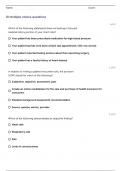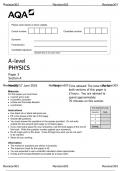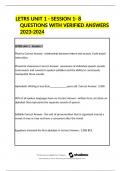Anti-Arrhythmic Drugs (Basic Concepts)
Tuesday, November 26, 2019 7:53 PM
• Arrhythmia is any deviation from normal rhythm of the heart
• Arrhythmia means when heart is not in an normal rhythm
• Rhythm means any activity which is occurring again and again at same
interval
• Cardiac Rhythm has 4 components and normal cardiac rhythm result from
Normal generation of Cardiac impulse and Normal conduction of cardiac
impulse
Factors Define a Normal Cardiac Rhythm
1. In Normal rhythm H.R should be between 60-100 per minute
To have a normal Rhythm H.R should be normal i.e 60-100 beats per minutes
and if H.R is less than 60 then it is bradyarrhythmia's and if H.R is more
than 100 then it is tachyarrhythmias
2. To have normal H.R origin of electrical activity of the heart should be
normal
• Normally Cardiac impulses are generated from SA node and if heart is
having origin of impulses not from SA node For example AV node produces
electrical current; it is acting as a pacemaker of the heart so that is
abnormal rhythm i.e arrhythmia
• Normally electrical impulses produced by SA node, it should spread over
atria and depolarize the atria and after that cardiac impulse should pass
through AV node then it should pass through bundle of his and purkinje
system and eventually to the ventricular myocardium so it means it should
conduct through normal conduction pathway
3. Cardiac impulse should pass through conduction pathway with normal
velocity
4. Cardiac impulse passes through atria with moderate velocity i.e 1 meter per
second
Cardiac impulse should pass through AV node with very slow velocity i.e 0.05
Anti-Arrythmic Drugs (Basic Concepts) Page 1
,• Cardiac impulse should pass through AV node with very slow velocity i.e 0.05
meter per second
• Cardiac impulse should pass through bundle of his and purkinje system with
very high velocity i.e 4-5 meter per second
If due to any reason if heart is not following these factors then we say
there is Arrhythmias
• Electrical and mechanical activity have to be normal to produce normal CO
if heart goes out of rhythm due to any mechanisms which will lead to severe
arrhythmias which will lead to reduced CO and may produce syncope which
is transient loss of consciousness due to reduced CO which is leading
transient reduction in cerebral function or may produce palpitations which
is unpleasant awareness of cardiac activity or may produce unstable
hemodynamic situations or patient may come with abnormal pulse or patient
may come with precipitation of Cardiac failure or someone who has ischemic
heart disease then it can be precipitated by cardiac arrhythmias and
cardiac arrhythmias can precipitate ischemic heart disease
• Cardiac arrhythmias are one of the cause of cardiac death
• Cause and mechanisms of arrhythmias are problem with the generation of
the cardiac impulse or there is problem with the conduction of the cardiac
impulse it means all the anti arrhythmic drugs has one of the function of
alter the cardiac impulse generation or alter the cardiac impulse conduction
Few Important Terms
• Simple Tachycardias= are when H.R keep on increasing between 100-150 per
minute
• Paroxysmal Tachycardia= tachycardia suddenly appear between 150-250 per
minute then disappear
• Flutters=If cardiac impulse generation is between rate of 250-350 per
minute
• Fibrillations= If cardiac impulses generation is more than 350 per minute
• Tachyarrhythmias= if cardiac impulse generation is more than 100 then all
terms should call Tachyarrhythmias
Anti-Arrythmic Drugs (Basic Concepts) Page 2
, terms should call Tachyarrhythmias
• Simple Tachycardia maybe originating from SA node so simple tachycardia
can be called "Sinus Tachycardia"
• If AV node is overstimulated due to some disease process or by some drug
and start driving ventricles fast or purkinje system is overstimulated and
drive ventricles fast then that will become Junctional tachycardia or Nodal
tachycardia
• If junctional tachycardia and nodal tachycardia becomes very fast and
suddenly appear and disappear then we called them paroxysmal nodal
tachycardia or paroxysmal junctional tachycardia
• In the same way if there is abnormal activity in atria and atrial impulses
between 250-350 times per minute then we say atrial flutter and if similar
problem occur with the ventricles like ventricles having 250-350 times per
minute then we call it ventricular flutter and in the same way there can be
atrial fibrillations and there can be ventricular fibrillations
Mechanisms Of Arrhythmias
• All the patient who come with arrhythmias underlying electrical mechanisms
should be either they are having abnormal electrical impulse generation or
abnormal electrical impulse conduction or some patient may have both
problems
• Automaticity= defined as capability of the cell to undergo depolarization
spontaneously, such cell which has capability to undergo depolarization
spontaneous
• Myocardium can be divided into 2 types of cell as far as electrical activity
is concerned: cells who have natural tendency of automaticity and cells that
do not have
• Myocardial cells which have property of automaticity they will produce
cardiac impulse
• ; these cells have capacity of pacemaker function
AV, SA and Purkinje system has tendency to produce automatic cardiac
Anti-Arrythmic Drugs (Basic Concepts) Page 3
, • AV, SA and Purkinje system has tendency to produce automatic cardiac
impulses
• Most of the remaining atrial and ventricular cells do not produce
automaticity
• Why some cells automatically fire and some cells can not?
• Why in SA nodal cells it goes from -60(RMP)to -40(threshold)
automatically?
=SA nodal has leaky Na channels with little Ca Channels; even when SA nodal
cells resting some Na leak in and some Ca leak in and also very little K is coming
out so cells are progressively being loaded with cations so -60 is neutralized
and will become -40, as soon as it reaches to threshold then voltage sensitive
Ca channels open and lot of Ca comes in and takes the threshold potential to 0
i.e -40 is fully neutralized so it is depolarized then voltage sensitive K channels
open lot of K goes out and as more and more K is lost out then cell becomes
more electro- so cell again becomes -60 volt (RMP) and this process will repeat
every 0.8 second and in every minute normally 72 depolarization and
repolarization will produced in SA nodal cell
• What is happening in atrial cells?
= In healthy atrial cell, RMP can’t move automatically to threshold because
it does not have leaky cationic channels; when atrial cells are resting then
very little Na and Ca go in and little K goes out but influx of cations and
outflux of cations is equal so RMP remains stable and does not move
towards threshold, it will only move towards threshold when adjacent
cell(SA nodal) will push some cations into atrial cell, remember SA nodal
cells are connected with atrial cells through gap junctions, so when SA
nodal cells will go under depolarization and got lot of Ca and little Ca will go
into Atrial Cell from SA nodal cell and that Ca will take RMP of atrial cell to
threshold then voltage sensitive Na channels will open and atrial cell quickly
will depolarize and these phenomenon is called zero phase of action
potential, after that Na channels will become off and K will start moving out
along with that Ca ill be coming in so both currents are moving
simultaneously i.e gain and loss of cation is equal that cell remains in the
plateau. As time passes by Ca channels become off and K channels become
overactive and there is active loss of cations which leads to plateau
potential towards the repolarization. Remember SA nodal cell depolarization
was dependent on Ca and atrial cell depolarization was dependent on Na.
Due to these reason SA nodal cell, AV nodal cell and purkinje system have
an inherant tendency of automaticity and atrial cell and ventricular cell do
not have tendency to spontaneously move towards threshold automatically
so they are not pacemaker cell
Anti-Arrythmic Drugs (Basic Concepts) Page 4
Tuesday, November 26, 2019 7:53 PM
• Arrhythmia is any deviation from normal rhythm of the heart
• Arrhythmia means when heart is not in an normal rhythm
• Rhythm means any activity which is occurring again and again at same
interval
• Cardiac Rhythm has 4 components and normal cardiac rhythm result from
Normal generation of Cardiac impulse and Normal conduction of cardiac
impulse
Factors Define a Normal Cardiac Rhythm
1. In Normal rhythm H.R should be between 60-100 per minute
To have a normal Rhythm H.R should be normal i.e 60-100 beats per minutes
and if H.R is less than 60 then it is bradyarrhythmia's and if H.R is more
than 100 then it is tachyarrhythmias
2. To have normal H.R origin of electrical activity of the heart should be
normal
• Normally Cardiac impulses are generated from SA node and if heart is
having origin of impulses not from SA node For example AV node produces
electrical current; it is acting as a pacemaker of the heart so that is
abnormal rhythm i.e arrhythmia
• Normally electrical impulses produced by SA node, it should spread over
atria and depolarize the atria and after that cardiac impulse should pass
through AV node then it should pass through bundle of his and purkinje
system and eventually to the ventricular myocardium so it means it should
conduct through normal conduction pathway
3. Cardiac impulse should pass through conduction pathway with normal
velocity
4. Cardiac impulse passes through atria with moderate velocity i.e 1 meter per
second
Cardiac impulse should pass through AV node with very slow velocity i.e 0.05
Anti-Arrythmic Drugs (Basic Concepts) Page 1
,• Cardiac impulse should pass through AV node with very slow velocity i.e 0.05
meter per second
• Cardiac impulse should pass through bundle of his and purkinje system with
very high velocity i.e 4-5 meter per second
If due to any reason if heart is not following these factors then we say
there is Arrhythmias
• Electrical and mechanical activity have to be normal to produce normal CO
if heart goes out of rhythm due to any mechanisms which will lead to severe
arrhythmias which will lead to reduced CO and may produce syncope which
is transient loss of consciousness due to reduced CO which is leading
transient reduction in cerebral function or may produce palpitations which
is unpleasant awareness of cardiac activity or may produce unstable
hemodynamic situations or patient may come with abnormal pulse or patient
may come with precipitation of Cardiac failure or someone who has ischemic
heart disease then it can be precipitated by cardiac arrhythmias and
cardiac arrhythmias can precipitate ischemic heart disease
• Cardiac arrhythmias are one of the cause of cardiac death
• Cause and mechanisms of arrhythmias are problem with the generation of
the cardiac impulse or there is problem with the conduction of the cardiac
impulse it means all the anti arrhythmic drugs has one of the function of
alter the cardiac impulse generation or alter the cardiac impulse conduction
Few Important Terms
• Simple Tachycardias= are when H.R keep on increasing between 100-150 per
minute
• Paroxysmal Tachycardia= tachycardia suddenly appear between 150-250 per
minute then disappear
• Flutters=If cardiac impulse generation is between rate of 250-350 per
minute
• Fibrillations= If cardiac impulses generation is more than 350 per minute
• Tachyarrhythmias= if cardiac impulse generation is more than 100 then all
terms should call Tachyarrhythmias
Anti-Arrythmic Drugs (Basic Concepts) Page 2
, terms should call Tachyarrhythmias
• Simple Tachycardia maybe originating from SA node so simple tachycardia
can be called "Sinus Tachycardia"
• If AV node is overstimulated due to some disease process or by some drug
and start driving ventricles fast or purkinje system is overstimulated and
drive ventricles fast then that will become Junctional tachycardia or Nodal
tachycardia
• If junctional tachycardia and nodal tachycardia becomes very fast and
suddenly appear and disappear then we called them paroxysmal nodal
tachycardia or paroxysmal junctional tachycardia
• In the same way if there is abnormal activity in atria and atrial impulses
between 250-350 times per minute then we say atrial flutter and if similar
problem occur with the ventricles like ventricles having 250-350 times per
minute then we call it ventricular flutter and in the same way there can be
atrial fibrillations and there can be ventricular fibrillations
Mechanisms Of Arrhythmias
• All the patient who come with arrhythmias underlying electrical mechanisms
should be either they are having abnormal electrical impulse generation or
abnormal electrical impulse conduction or some patient may have both
problems
• Automaticity= defined as capability of the cell to undergo depolarization
spontaneously, such cell which has capability to undergo depolarization
spontaneous
• Myocardium can be divided into 2 types of cell as far as electrical activity
is concerned: cells who have natural tendency of automaticity and cells that
do not have
• Myocardial cells which have property of automaticity they will produce
cardiac impulse
• ; these cells have capacity of pacemaker function
AV, SA and Purkinje system has tendency to produce automatic cardiac
Anti-Arrythmic Drugs (Basic Concepts) Page 3
, • AV, SA and Purkinje system has tendency to produce automatic cardiac
impulses
• Most of the remaining atrial and ventricular cells do not produce
automaticity
• Why some cells automatically fire and some cells can not?
• Why in SA nodal cells it goes from -60(RMP)to -40(threshold)
automatically?
=SA nodal has leaky Na channels with little Ca Channels; even when SA nodal
cells resting some Na leak in and some Ca leak in and also very little K is coming
out so cells are progressively being loaded with cations so -60 is neutralized
and will become -40, as soon as it reaches to threshold then voltage sensitive
Ca channels open and lot of Ca comes in and takes the threshold potential to 0
i.e -40 is fully neutralized so it is depolarized then voltage sensitive K channels
open lot of K goes out and as more and more K is lost out then cell becomes
more electro- so cell again becomes -60 volt (RMP) and this process will repeat
every 0.8 second and in every minute normally 72 depolarization and
repolarization will produced in SA nodal cell
• What is happening in atrial cells?
= In healthy atrial cell, RMP can’t move automatically to threshold because
it does not have leaky cationic channels; when atrial cells are resting then
very little Na and Ca go in and little K goes out but influx of cations and
outflux of cations is equal so RMP remains stable and does not move
towards threshold, it will only move towards threshold when adjacent
cell(SA nodal) will push some cations into atrial cell, remember SA nodal
cells are connected with atrial cells through gap junctions, so when SA
nodal cells will go under depolarization and got lot of Ca and little Ca will go
into Atrial Cell from SA nodal cell and that Ca will take RMP of atrial cell to
threshold then voltage sensitive Na channels will open and atrial cell quickly
will depolarize and these phenomenon is called zero phase of action
potential, after that Na channels will become off and K will start moving out
along with that Ca ill be coming in so both currents are moving
simultaneously i.e gain and loss of cation is equal that cell remains in the
plateau. As time passes by Ca channels become off and K channels become
overactive and there is active loss of cations which leads to plateau
potential towards the repolarization. Remember SA nodal cell depolarization
was dependent on Ca and atrial cell depolarization was dependent on Na.
Due to these reason SA nodal cell, AV nodal cell and purkinje system have
an inherant tendency of automaticity and atrial cell and ventricular cell do
not have tendency to spontaneously move towards threshold automatically
so they are not pacemaker cell
Anti-Arrythmic Drugs (Basic Concepts) Page 4









